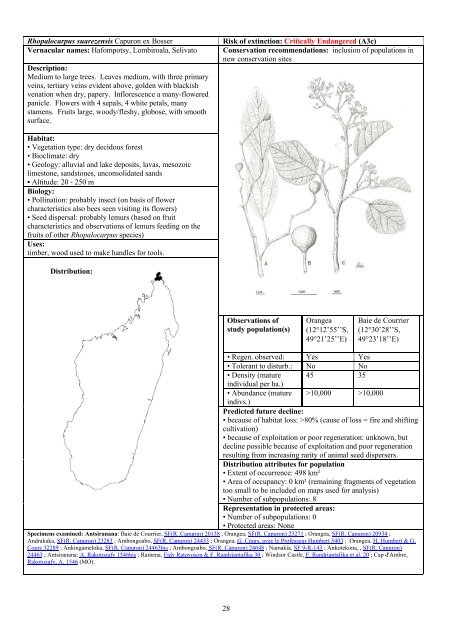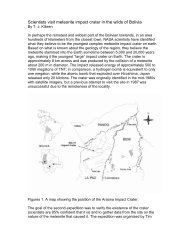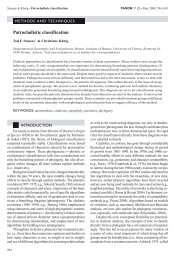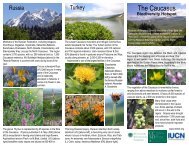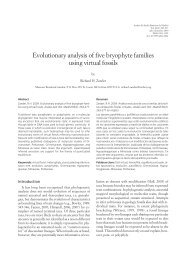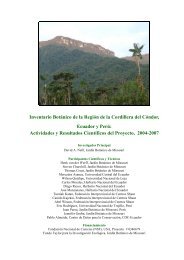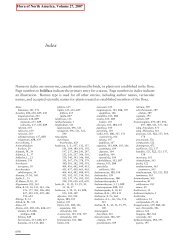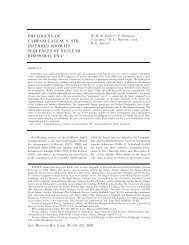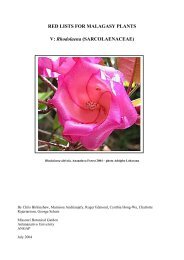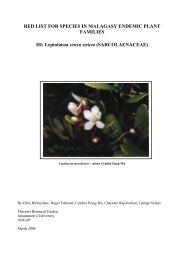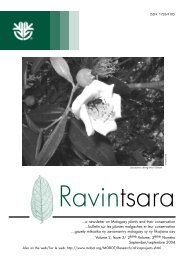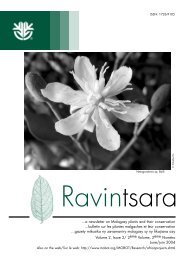red lists for malagasy plants iv: sphaerosepalaceae - Missouri ...
red lists for malagasy plants iv: sphaerosepalaceae - Missouri ...
red lists for malagasy plants iv: sphaerosepalaceae - Missouri ...
Create successful ePaper yourself
Turn your PDF publications into a flip-book with our unique Google optimized e-Paper software.
Rhopalocarpus suarezensis Capuron ex Bosser Risk of extinction: Critically Endange<strong>red</strong> (A3c)<br />
Vernacular names: Hafompotsy, Lombiroala, Sel<strong>iv</strong>ato Conservation recommendations: inclusion of populations in<br />
new conservation sites<br />
Description:<br />
Medium to large trees. Leaves medium, with three primary<br />
veins, tertiary veins evident above, golden with blackish<br />
venation when dry, papery. Inflorescence a many-flowe<strong>red</strong><br />
panicle. Flowers with 4 sepals, 4 white petals, many<br />
stamens. Fruits large, woody/fleshy, globose, with smooth<br />
surface.<br />
Habitat:<br />
• Vegetation type: dry decidous <strong>for</strong>est<br />
• Bioclimate: dry<br />
• Geology: alluvial and lake deposits, lavas, mesozoic<br />
limestone, sandstones, unconsolidated sands<br />
• Altitude: 20 - 250 m<br />
Biology:<br />
• Pollination: probably insect (on basis of flower<br />
characteristics also bees seen visiting its flowers)<br />
• Seed dispersal: probably lemurs (based on fruit<br />
characteristics and observations of lemurs feeding on the<br />
fruits of other Rhopalocarpus species)<br />
Uses:<br />
timber, wood used to make handles <strong>for</strong> tools.<br />
Distribution:<br />
Observations of<br />
study population(s)<br />
Orangea<br />
(12°12’55’’S,<br />
49°21’25’’E)<br />
Baie de Courrier<br />
(12°30’28’’S,<br />
49°23’18’’E)<br />
• Regen. observed: Yes Yes<br />
• Tolerant to disturb.: No No<br />
• Density (mature 45 35<br />
ind<strong>iv</strong>idual per ha.)<br />
• Abundance (mature >10,000 >10,000<br />
ind<strong>iv</strong>s.)<br />
P<strong>red</strong>icted future decline:<br />
• because of habitat loss: >80% (cause of loss = fire and shifting<br />
cult<strong>iv</strong>ation)<br />
• because of exploitation or poor regeneration: unknown, but<br />
decline possible because of exploitation and poor regeneration<br />
resulting from increasing rarity of animal seed dispersers.<br />
Distribution attributes <strong>for</strong> population<br />
• Extent of occurrence: 498 km²<br />
• Area of occupancy: 0 km² (remaining fragments of vegetation<br />
too small to be included on maps used <strong>for</strong> analysis)<br />
• Number of subpopulations: 8<br />
Representation in protected areas:<br />
• Number of subpopulations: 0<br />
• Protected areas: None<br />
Specimens examined: Antsiranana: Baie de Courrier, SF(R. Capuron) 20138 , Orangea, SF(R. Capuron) 23271 ; Orangea, SF(R. Capuron) 20934 ;<br />
Andrakaka, SF(R. Capuron) 23283 ; Ambongoabo, SF(R. Capuron) 24453 ; Orangea, G. Cours, avec le Professeur Humbert 5403 ; Orangea, H. Humbert & G.<br />
Cours 32289 ; Ankingameloka, SF(R. Capuron) 24463bis ; Ambongoabo, SF(R. Capuron) 24648 ; Namakia, SF 9-R-143 ; Ankotekona, , SF(R. Capuron)<br />
24463 ; Antsiranana: A. Rakotozafy 1546bis ; Ramena, Fidy Ratovoson & F. Randriantafika 30 ; Windsor Castle, F. Randriantafika et al. 20 ; Cap d'Ambre,<br />
Rakotozafy, A. 1546 (MO).<br />
28


